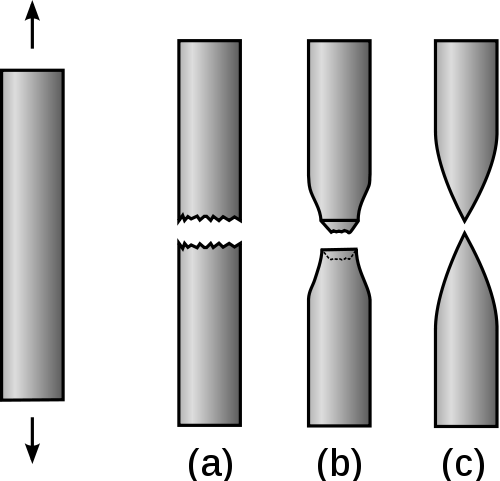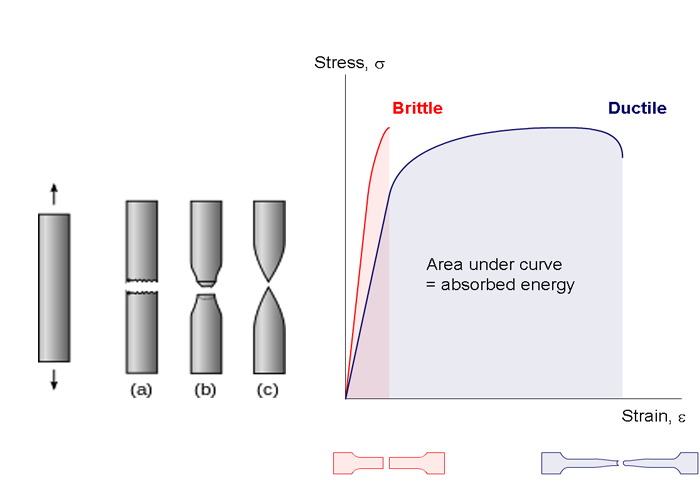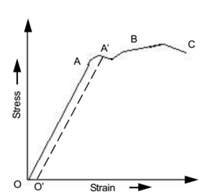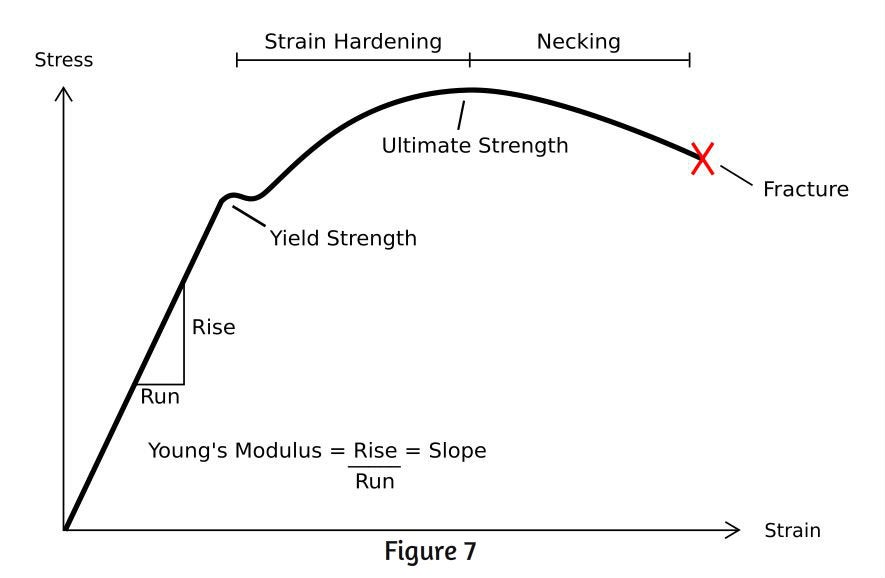Ductile Type Material Behavior Can Best Be Described as
Ductile behaviour The response to stress of certain materials which undergo permanent deformation without fracturing. Ductility is a mechanical property commonly described as a materials amenability to drawing.

Load Displacement Curves For Brittle And Ductile Materials Download Scientific Diagram
Also called sudden failure.

. A Dictionary of Earth Sciences dictionary. In contrast ductility is the ability of a solid material to deform under tensile stress. The temperature range over which the transition occurs is determined by Charpy and Izod impact tests.
Brittle materials break crack or snap easily. Ductile material will deform elongate more than brittle material. In this figure you can observe materials a break.
Ductility is an important consideration in engineering and manufacturing defining a materials suitability for certain manufacturing. The mode of fracture is highly dependent on the mechanism of crack propagation. Any fracture process involves two steps crack formation and propagation in response to an imposed stress.
General ductile materials experience large strains before failure whereas brittle materials experience relatively little strain before failure. A material is said to be ductile if it can be stretched thin when tensile stress is administered. The subject is of great importance in engineering because the phenomenon of ductility allows a material to redistribute localized stresses.
A material is considered to be ductile if it is capable of undergoing a large amount of plastic deformation before failure. Ductility or brittleness is highly temperature dependent. Ductile materials can be drawn into wires by stretching.
QUESTION 1 Ductility of a material is best described as. For example a brittle material can behave like a ductile one at an elevated temperature. Ductility is a measure of a metals ability to withstand tensile stressany force that pulls the two ends of an object away from each other.
Such a material can be stretched into a wire. The game of tug-of-war provides a good example of tensile stress being applied to a rope. The brittle material is glass Plain concrete cast iron etc.
Ductile materials show large deformation before fracture. Source for information on ductile behaviour. Brittle material absorbs little energy prior to rapture.
Ductile materials can be stretched without breaking and drawn into thin wires. A malleable material is one in which a thin sheet can be easily formed by hammering or rolling. This is different from malleability which describes a material that can bend or alter shape using compressive force eg.
The term Ductility could be define as the property of a matter mostly existed metals that could be easily beatendrawn into wire. Ductile materials show deformation. This produces permanent strain marked by smooth variations within the deformed rock.
In contrast ductility is the ability of a solid material to deform under tensile stress. Ductility is the plastic deformation that occurs in metal as a result of such types of strain. Similarly a ductile material at room temperature when frozen can automatically convert into brittle material.
Updated on December 30 2018. Aluminum copper tin mild steel platinum and lead are examples of ductile materials. Ductility or brittleness of a material also depends on the inbuilt stress level.
In other words the material has the ability to deform under compressive stress. Materials can be either ductile or brittle depending on their stress-strain behavior. In ductile fracture extensive plastic deformation necking takes place before fracture.
One can bend a hook on a rebar and even unbend it without breaking Brittle behavior means that the material will break without warning Catastrophic Failure. More the metal will be ductile much longer the wire could be drawn. Ductility is affected by temperature.
Tensile stress is a type of force or stress that alters the length of a. As far as my knowledge its because of - If we talk about the arrangement of atoms or u can say its Bravias lattice you will get your answer. Recall pulling is applying tensile stress.
Answer 1 of 2. Brittle materials do not show deformation. The ductile materials are Steel Aluminum copper etc.
Advertisement Answer 35 5 7 OlaMacgregor Is malleable and ductile. Hammering rather than tensile stress. Factors Affecting the Process.
Ductility Ability of a material to deform under tensile stress Shows obvious deformation before fracture and will absorb more energy Strength Ability of material to resist stress Toughness Ability of material to absorb energy before fracturing Energy under stress strain curve is. A ductile substance can be drawn into a wire. Ductility is an important property for manipulating these metals by hammering drawing or rolling.
A materials modulus of rigidity a materials ability to deform after yielding a materials percent elongation a materials ultimate tensile stress 5 points QUESTION 2 1. The transition from ductile to brittle behavior with a decrease in temperature exhibited by some low-strength steel BCC alloys. Brittle materials break without significant plastic deformation under tensile stress.
Practically a ductile material is a material that can easily be stretched into a wire when pulled as shown in the figure below. A material is brittle if when subjected to stress it. Ductile behavior is the ability of a material to stretch andor bend without suddenly breaking and after the load is removed it can remain stretchedbent and then be re-loaded.
The maximum stress amplitude level below which a material can endure an essentially infinite number of stress. Normally materials have 14 different type of bravias lattice arrangement of atoms for example FCCFace cubuc centerBCCBody cubic. Ductility is the ability of a material to be elongated in tension.
We review their content and use your feedback to keep the quality high. In materials science ductility is defined by the degree to which a material can sustain plastic deformation under tensile stress before failure. Updated on September 16 2019 Ductility is the physical property of a material associated with the ability to be hammered thin or stretched into wire without breaking.
Most metals are good examples of ductile materials including gold silver copper erbium terbium and samarium. Ductile fracture shear fracture is better than brittle fracture because there is slow propagation and an absorption of a large amount energy before fracture. How ductile or brittle a material is provides engineers insight into what different materials may be best suited for certain applications.

Load Displacement Curves For Brittle And Ductile Materials Download Scientific Diagram

Difference Between Ductile And Brittle Materials Youtube

What Is Ductility Meaning Factors That Affect Engineering Choice

What Is A Brittle Material Matse 81 Materials In Today S World

Ductility Definition Examples Video Lesson Transcript Study Com

Malleability And Ductility Matse 81 Materials In Today S World
What Are The Differences Between Brittle And Ductile Metals With Respect To Its Tensile Stress Strain Behavior Quora
Why Are Brittle Materials Designed On The Basis Of Ultimate Tensile Strength While Ductile Materials Are Designed On The Basis Of Yield Strength Quora
Difference Between Ductile And Brittle Definition Examples Effect Of Temperature Differences

Ductility An Overview Sciencedirect Topics
Stress Strain And The Stress Strain Curve Materials Science Engineering

Behaviour Of Ductile Material Of Wire Under Increasing Load

Behavior Of Brittle And Ductile Material Download Scientific Diagram

Steps To Analyzing A Material S Properties From Its Stress Strain Curve 9 Steps Instructables

Ductile Metal An Overview Sciencedirect Topics
Overview Brittle And Ductile Materials
Difference Between Ductile Material And Brittle Material

Ductility An Overview Sciencedirect Topics
What Is The Material Behavoiur Of Glass It Is Brittle Or Ductile Quora
Comments
Post a Comment